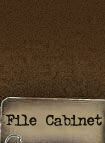|
REASON FOR INVESTIGATION:
The scene in the 1977 war movie "A
Bridge Too Far" where "General
Ludwig" (an assumed name for General
Heinz Harmel) gives the order to
blow the bridge across the Waal
River at Nijmegen, The Netherlands,
at the very moment Allied tanks roll
across it, has become a classic. We
captured the essence of this
spine-chilling scene in the above
animation. For the whole scene,
click
here!
"A Bridge Too Far" is based on
author Cornelius Ryan's book with
that same title. The scene at the
Nijmegen bridge is the Hollywood
depiction of an event that actually
took place on the 20th of September
1944. Much has been written about
the reason or the cause for the
Nijmegen bridge to remain intact. In
this Battle Study we investigate
only a limited aspect of the events
near the bridge. Where were the
general and his detonator-operator
when he ordered the bridge to be
blown?
SYNOPSIS:
Introduction
The capture of the bridge at
Nijmegen was part of an Allied
operation named Market Garden. This
operation was already in its fourth
day and the plan dictated this river
crossing to be in Allied hands at
least two days earlier. On D+3 of
the operation, American paratroopers
of the 504th Parachute Infantry
Regiment paddled across the Waal
River, in small fabric-walled boots,
originally designed for bridging
engineer units. Once across the
river, they attacked the bridge from
its Northern ramp. Meanwhile, their
sister-Regiment, the 505th, fought
its was through the city of
Nijmegen, to capture the bridge from
it Southern approach road.

German SS General Heinz Harmel
of the 10th SS Armored "Frundsberg"
Division had been given the task to
attack American paratroopers in the
Nijmegen area. In a very early stage
of Operation Market Garden, the
Germans understood the intention of
the plan. The saw that the city of
Arnhem and its bridge across the
Rhine River was the main objective.
The last large river span, before
reaching Arnhem, was the one at
Nijmegen. It was for this reason
that Harmel asked his superior,
Field-Marshall Model, for permission
to destroy the Nijmegen bridge in
the event the Allies succeeded in
capturing it.
Model, however, refused this order
and told Harmel to hold the bridge
at all cost.
The Nijmegen bridge had, in the
previous years of German occupation
of the Dutch city of Nijmegen, been
prepared for demolition. Blocks of
explosive material, custom-shaped to
fit inside the steel girders of the
bridge, had been mounted on critical
sections of the bridge. The
detonation device had been placed on
the Northern bank of the Waal river.
The reason for this, was that the
Germans expected attacks on the
bridge to come from the South.
The order to blow the bridge
I Cornelius Ryan's book A Bridge Too
Far, General Harmel recalled:
'What must be done first? What is
the most urgent, most important
action to take? It all came down to
the bridges' He had not contacted
Bittrich 'beforehand to warn him
that I might have to demolish the
highway crossing. I presumed that it
was Bittrich who had ordered the
bridges readied for demolition.' So,
Harmel reasoned, in spite of Model's
order, 'if Bittrich had been in my
shoes, he would have blown the main
bridge. In my opinion, Model's order
was now automatically canceled
anyway.' At any moment he expected
tanks to appear on the highway
bridge.'
A few moments later he ordered the
bridge to be blown, only to witness
the detonating system to malfunction
and the road bridge to remain
intact.
Cause of the detonator to
malfunction
After World War Two, in Holland a
nationwide discussion developed
about why the Nijmegen bridge was
not destroyed by the Germans.
Wire sabotaged by Dutch
resistance fighter
A Dutch government Enquiry Committee
was formed to investigate the claim
that a local Nijmegen resistance
fighter, named Jan van Hoof had cut
the wires and by doing so, made it
impossible for the Germans to blow
it up.
Volumes have been written about the
role of Jan van Hoof and the Enquiry
Committee's 1951 report is a large
one.
As stated earlier, this Battle
Study will not focus on this aspect.
We refer our viewers to Dutch
official World War Two historian
Dr. Lou de Jong's summary of the
Committee's findings.
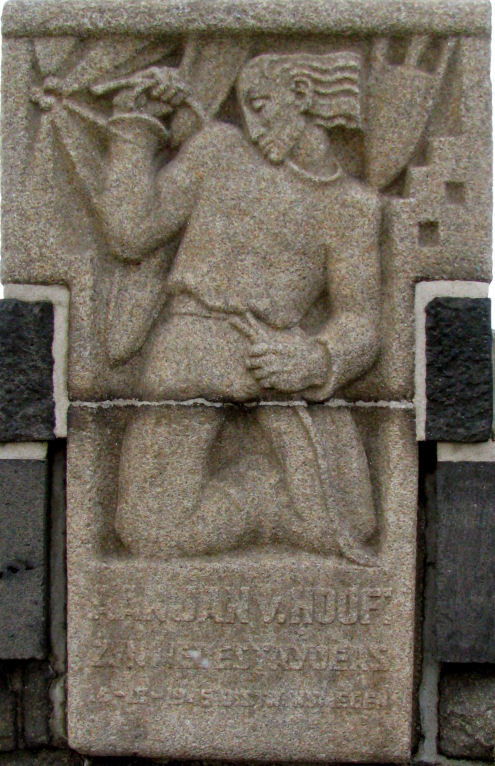
Monument to Jan van
Hoof on the Waal River Bridge,
Nijmegen

Monument to Jan van
Hoof on Joris Ivens Plein, Nijmegen
"On this spot Jan van Hoof, savior
of the Waal River Bridge, fell,
September 19th, 1944"
Detonator wire cut by artillery
fire
Very interesting is Cornelius Ryan's
footnote:
"This is the first account of the
German attempt to destroy the
Nijmegen highway bridge. General
Harmel had never before given an
interview to anyone on the subject."
This is a remarkable statement
because Harmel had written his
account of his 9th SS Armored
Division in the Nijmegen area, which
was published in the September 1956
issue of Der Freiwillige; a not
uncontroversial magazine for
veterans of former German SS-units:
(click on the
thumbnails for the full-size
magazine pages)
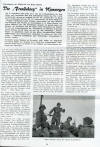

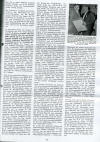

(magazine article
through Bundesarchiv, Militärarchiv,
Germany)
In this light, the following segment
is very interesting:

Robert J. Kershaw translated this
segment in his book "It never snows
in September, The German view of
MARKET-GARDEN and the Battle of
Arnhem, September 1944", as follows:
'I now gave the order, on my own
responsibility, to blow the road
bridge, over which further tanks
continued to advance . It failed to
go up – probably because the
initiation cable had been cut by
artillery fire'.
Inspection of demolition charges
by Royal Engineers
Adding to the confusion that still
remains in relation to what
prevented the bridge from being
destroyed, is the account of Lt.
Col. A.G.C Jones (a 1st Lieutenant
in 1944), troop commander of No. 14
Field Squadron, Royal Engineers.
In September 1967,
Jones was interviewed for
Cornelius Ryan's book A Bridge Too
Far.
Jones' job on the 20th was to make
sure that all demolition charges
were destroyed. As this diagram from
his hand shows, Jones was right
behind the attacking tanks and
should therefore be considered as
the first expert on the scene to
inspect the explosive devices:
(click on the image
to enlarge)

In his interview he stated this
about the system of explosive
devices that he discovered on
and
around Nijmegen bridge:

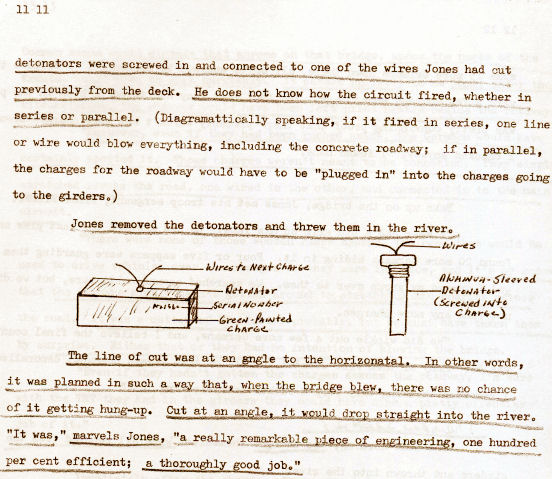
Jones is even more convincing in
this written statement:
(click on the image
to enlarge)

Location of the detonator
During the course of the
investigation of the Dutch Enquiry
Committee, no relevant German
sources where consulted or
interviewed. If General Harmel would
have told his story to the
Committee, as he told it to
Cornelius Ryan, the conclusion that
it was Field Marshall Model's order
that saved the Nijmegen bridge,
would have never found its way into
the official report.
We will now focus on the exact
location where General Harmel
watched the British tanks cross the
Waal River road bridge and ordered
the operating engineer to crank the
handle of the detonating device.
Location in movie "A Bridge Too
Far"
A Bridge Too Far was filmed on many
historical locations in The
Netherlands. Most of the scenes of
the Nijmegen bridge were 'shot' on
and around the original bridge. In
the movie, General Harmel's bunker
is located on the South-East bank of
the Waal river, somewhere at the
site where paratroopers of the US
504th Regiment started their
crossing on the 20th of September:
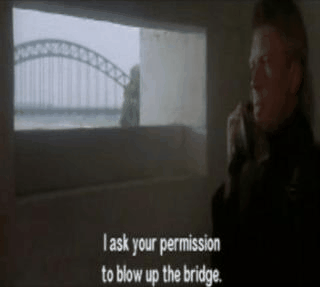
Location, according to Dutch
historian Karel Margry
In his richly illustrated, 2 volume
book "Market Garden, Then & Now",
Dutch historian
Karel Margry
published this about the location of
the detonator and of General
Harmel's observation point:
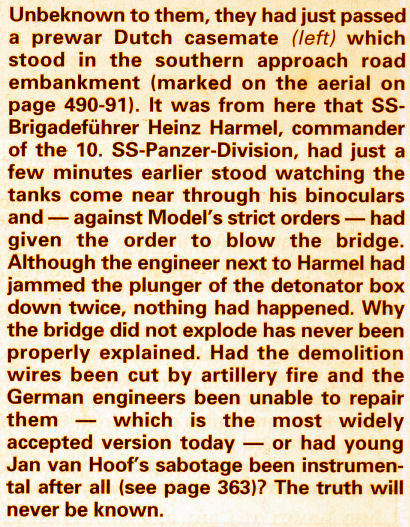
(click on the
thumbnail for the full-size
photograph and caption)
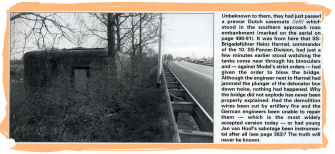
We visited this location and took
the following photographs:
(click on the
thumbnails to enlarge)
We found this location unlikely for
the spot where Harmel watched for
the right moment to gave the order
for the demolition of the bridge.
Harmel's account in Ryan's book A
Bridge Too Far
gives several clues:
"Binoculars to his eyes, he
stood on the roof of a bunker near
the village of Lent. From this
position on the northern bank of the
Waal barely a mile from the main
Nijmegen highway bridge, he could
see smoke and haze off to his right
and hear the crash of battle."
[...]
The detonator for the highway
bridge was hidden in a garden near
the bunker at Lent, and a man was
stationed there awaiting orders to
press the plunger."
[...]
Standing next to the engineer by
the detonator box, Harmel scanned
the crossing. At first he could
detect no movement. Then suddenly he
saw "a single tank reach the center,
then a second behind and to its
right." To the engineer he said,
"Get ready." Two more tanks appeared
in view, and Harmel waited for the
line to reach the exact middle
before giving the order. He shouted,
"Let it blow!" The engineer jammed
the plunger down. Nothing happened.
The British tanks continued to
advance. Harmel yelled, "Again!"
Once more the engineer slammed down
the detonator handle, but again the
huge explosions that Harmel had
expected failed to occur. "I was
waiting to see the bridge collapse
and the tanks plunge into the
river," he recalled. "Instead, they
moved forward relentlessly, getting
bigger and bigger, closer and
closer." He yelled to his anxious
staff, "My God, they'll be here in
two minutes!"
This account is based on the
interviews that Ryan had with Harmel
on November 2nd and 22nd and on
December 6th, 1967. A transcript of
these interviews is kept at the
University of Ohio in, Athens, Ohio.
This is the most important
section from that interview,
provided to us from the curator of
the Ryan Collection, Mr. Douglas
McCabe:

From: Ryan Collection
Box 130:12
“[...]
I had come alone, driven there by my
driver Hinterholzer.
[...]
It was on the 20th, about 18:30 when
I first received a report that the
British tanks had reached the
southern bank of the Waal and that
they were starting over the bridge.
Almost simultaneously the message
reporting this heavy smoke screen
arrived. Nothing could be seen but
it was obvious that the Americans
were making an attempt to cross the
river. Then I made up my mind to
blow the bridge as I told you.
I was near Lent and I had my driver
drive me to the edge of Lent. I
crossed the town on foot till I
reached the eastern edge. I knew
that the engineers who had come on
the evening of the 17th were there.
I presumed it was they who had
prepared the bridge for blowing. The
detonator box was hidden in a
garden, well camouflaged. A man was
stationed there in case the order to
blow the bridge should be given. I
stood beside him and watched the
tanks advancing on the bridge. I was
waiting for them to reach the middle
of the bridge before giving the
order. Then I gave it: “O.K. Let it
blow.” He pressed the plunger and
nothing happened. The British tanks
kept advancing. It took me a couple
of seconds to realize that the
charge had not gone off. Then I
thought: “My God! They’ll be here in
two minutes.” Then my thoughts began
darting about madly, trying to
decide what to do next. I could no
longer afford to worry about the
bridge. It was too late.
It was quite a shock I can tell you
to expect to see one thing, and then
see another. I expected to see the
bridge collapse and the tanks to be
plunged into the river. But instead
I could see the tanks move forward
relentlessly. They got bigger and
bigger, came closer and closer. Then
we dove for cover behind a bush.
[...]
When the bridge did not explode we
took cover. We knew that the British
could probably see us from their
tanks. They might start shooting
from the tanks with their machine
guns. Also the infantery (sic)
was bound to be coming behind
them. We could expect to be involved
in close combat within a very few
minutes.
[...]
After I started things moving I went
back to my car and drove to Bemmel.
[...]”
Where Ryan got his knowledge
about Harmel standing on the roof of
a casemate can not be found in the
transcript of the interview.
However, the last part makes it very unlikely
that the case mate in the photograph
in Margry's book was the one that Harmel stood on to observe the
Nijmegen bridge. From the North ramp
of the bridge any vehicle - tank or
soft skin - would be next to this
casemate in mere seconds. We took
these photographs standing next to
the casemate, looking toward the
bridge. We only used a built-in 10x
zoom lens:
(click on the
thumbnails to enlarge)
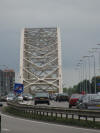
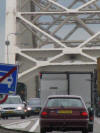
Location, according to
Battledetective.com
To analyze the phrase "The
detonator for the highway bridge was
hidden in a garden near the bunker
at Lent'" we scouted the area
around the casemate for a garden of
clues to a cleared one. From our position on the North
ramp we suddenly became aware of
another casemate close to our
position:
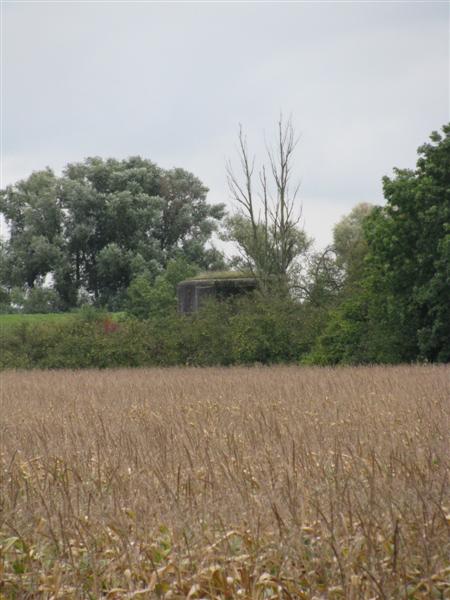
We walked toward this site and found
this bunker on the North bank a few
hundred yards to the West:
(click on the
thumbnails to enlarge)



Our investigators interviewed the
property owner. He explained us that
today the casemate belongs to a
private owner and although it is
situated within his land, he has to
grand the owner passage to it.
Apart from any legal ownership
issues we could definitely see that
from the garden of the house, one
has a clear view of the traffic on
the road bridge.
(click on the
thumbnails to enlarge)


This graphic shows the positions of
both bunkers with yellow drawing
pins:
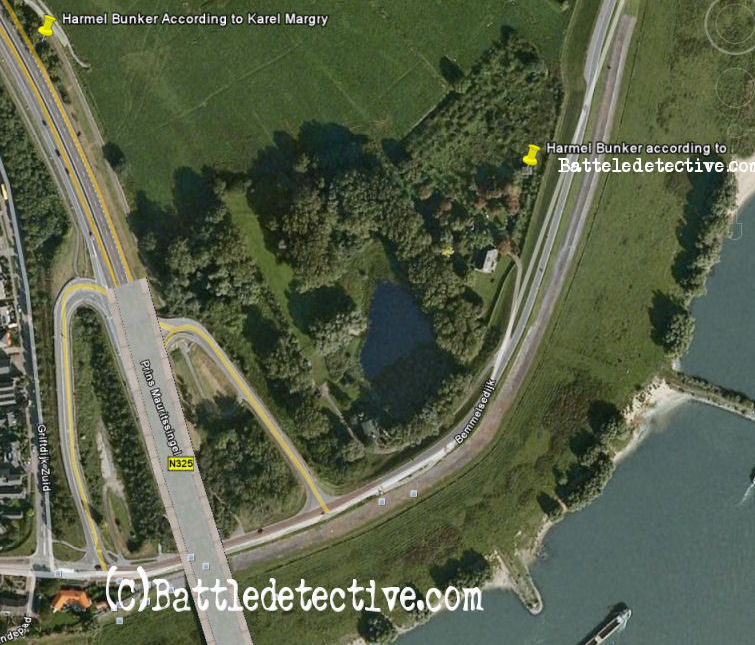
(c) Google Earth 2008
On this photograph from 1940 we can
see the Dutch casemate on the North
bank of the Waal River:
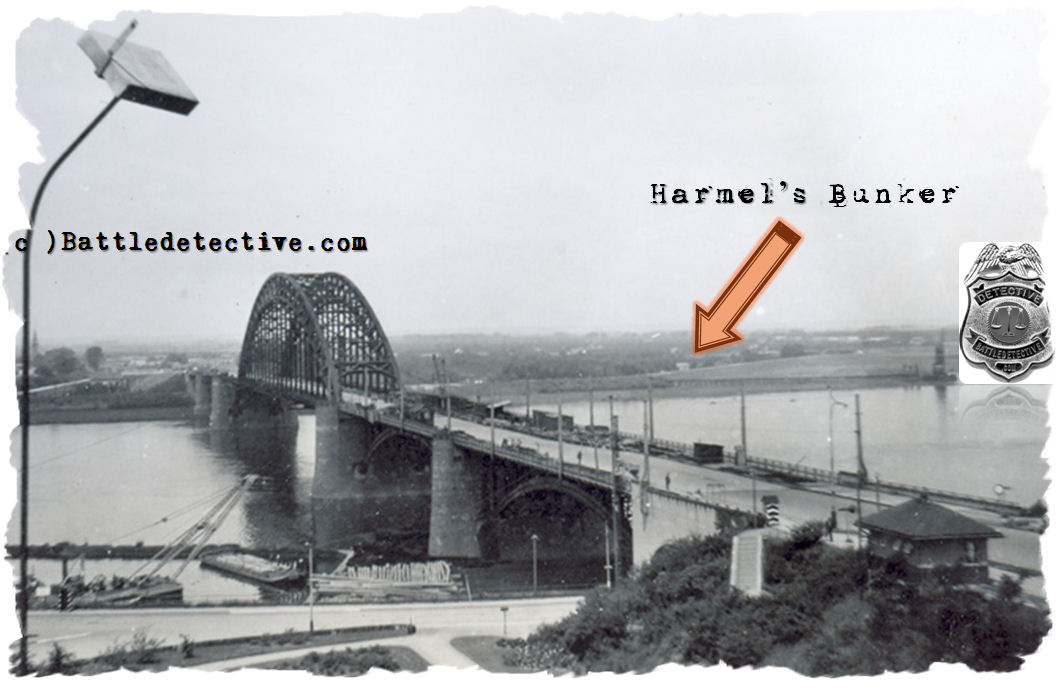
The casemate was designed to protect
the bridge but it could not prevent
its capture by the Germans in their
1940 Blitzkrieg war. Here we see the
casemate on a photograph taken by mr.
J.J. Overwater in April of 1941:
.JPG)
Also, a diagram, accompanying an
After Action Report of the 82nd
Airborne Division about the events
around Nijmegen Bridge on the 20th
of September 1944, indicates heavy
fire coming from the location of the
Bemmelse Dijk casemate. It is likely
that the detonator was in close
proximity of the artillery indicated
below:

CONCLUSIONS:
From the details in his interview
with Cornelius Ryan for A Bridge Too
Far, it is our theory that General
Harmel observed the road bridge at
Nijmegen by elements of the
Grenadier Guards from the casemate
on the north bank of the Waal river
that was, and still is, located in
the garden of the house on No.5
Bemmelse Dijk in Lent, Gelderland
province, The Netherlands. It was
from the garden around this
casemate, which has the designation
"LENT B 676" in the Dutch Real
Estate Registry ("Kadaster") that he
gave the command to operate the
detonator connected to the explosive
charges under the bridge..
|


